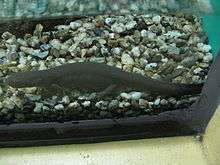Paddletail newt
| Paddle-tail newt | |
|---|---|
 | |
| Scientific classification | |
| Kingdom: | Animalia |
| Phylum: | Chordata |
| Subphylum: | Vertebrata |
| Class: | Amphibia |
| Order: | Caudata |
| Family: | Salamandridae |
| Genus: | Pachytriton |
| Species: | P. labiatus |
| Binomial name | |
| Pachytriton labiatus (Unterstein, 1930) | |
| Synonyms | |
| |
The paddle-tail newt (Pachytriton labiatus) is a species of newt, sometimes sold as household pets. They are found in China.
Description
The paddle-tail newt is characterized by a flat body and a long, paddle-like tail. They range from black to brown to pale brown. They have orange markings along the bottom of their bodies and may have some orange dots lining their backs. Their skin is very smooth with a secretion of mucus, and their limbs are relatively short. The morphology and size of this species are similar to, if not larger than, Pachytriton brevipes.[2]
They use their senses of sight and smell to locate food. Since food is scarce for them in their natural environments, they can go for weeks without eating, but should be fed regularly when kept in captivity. Paddle-tail newt longevity in the wild is currently unknown, but in captivity it usually ranges from 10–20 years.
Paddle-tail newts, uniquely, are known for their communication. They fan their tails when they are trying to attract the attention of another newt, when they are startled or frightened, or when approached by a conspecific.
Paddle-tail newts are sometimes confused with the Japanese fire belly newts and sold as such, but are much larger and more aggressive and will eat smaller firebelly newts if given the opportunity.
They have a similar relation named the spotted paddle-tail newt.
References
- ↑ Gu Huiqing; Yuan Zhigang (2004). "Pachytriton labiatus". IUCN Red List of Threatened Species. Version 2012.1. International Union for Conservation of Nature. Retrieved 26 July 2012.
- ↑ Amphibiaweb.org
